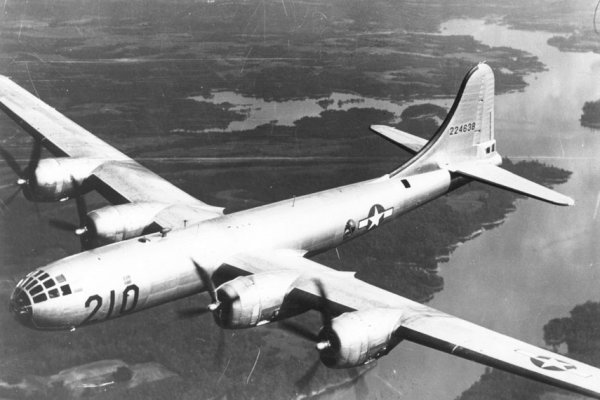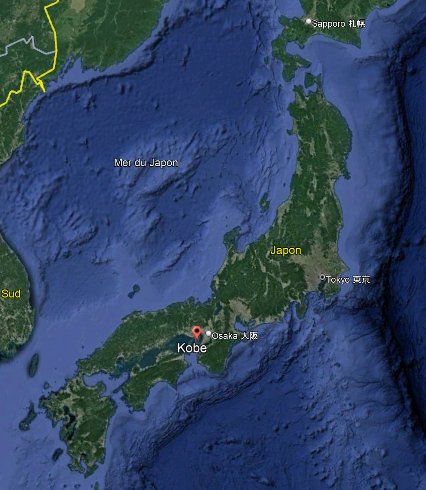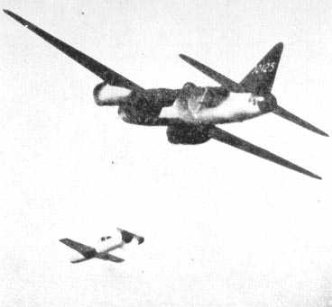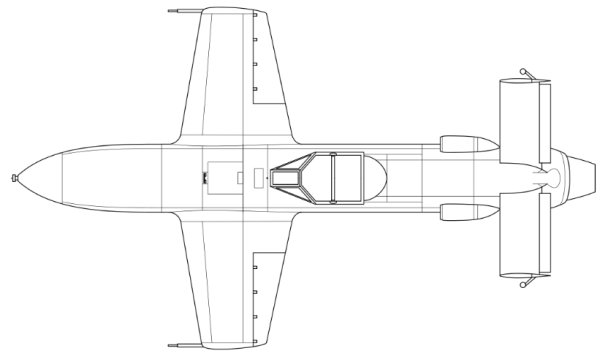ACUFO-1945-06-05-KOBE-1
In the XXIst Bomber Command tactical mission report of Mission 188, carried out on June 5, 1945, to bomb the urban area of Kobe, by B-29 bombers of the 58th, 73rd, 313th and 314th Bombardment Wings based at Tinian and Guam, I found an intriguing observation.
In the section of the report that documented the reactions of enemy aircraft, I read:
“After leaving the target, one B-29 crew at 17,000 feet observed 2 unidentified enemy aircraft on course of 140° T, at 20,000 feet. The enemy aircraft had very small wing spans and small fuselage with no discernible tail assembly. Both aircraft emitted a stream of dark blue smoke from the tail. No offensive were made, but the aircraft flew on the same heading for about 2 minutes and then turned back near land's end and toward Osaka.”
The report indicated the first target hit was at 07:32 a.m., the last target hit was at 08:47 a.m. This meant that the sighting took place between shortly after 7:32 and shortly after 8:47; the report specified that the target was hit during the day.
The report also stated that visibility was 15 miles with light haze.
| Date: | June 5, 1945 |
|---|---|
| Time: | 08:47 a.m. |
| Duration: | 2 minutes. |
| First known report date: | 1945 |
| Reporting delay: | Hours. |
| Country: | Japan |
|---|---|
| State/Department: | Hyogo |
| City or place: | Kobe |
| Number of alleged witnesses: | Several. |
|---|---|
| Number of known witnesses: | ? |
| Number of named witnesses: | 0 |
| Reporting channel: | Military operations report. |
|---|---|
| Visibility conditions: | Day, light haze. |
| UFO observed: | Yes. |
| UFO arrival observed: | ? |
| UFO departure observed: | Yes. |
| UFO action: | Flew on same heading then turned away. |
| Witnesses action: | |
| Photographs: | No. |
| Sketch(s) by witness(es): | No. |
| Sketch(es) approved by witness(es): | No. |
| Witness(es) feelings: | ? |
| Witnesses interpretation: | Unidentified enemy aircraft. |
| Sensors: |
[X] Visual: 2 or more.
[ ] Airborne radar: [ ] Directional ground radar: [ ] Height finder ground radar: [ ] Photo: [ ] Film/video: [ ] EM Effects: [ ] Failures: [ ] Damages: |
|---|---|
| Hynek: | DD |
| Armed / unarmed: | Armed, 12 Browning M2 12.7 mm machine guns. |
| Reliability 1-3: | 3 |
| Strangeness 1-3: | 2 |
| ACUFO: | Possible extraterrestrial craft. |
[Ref. aaf1:] US ARMY AIR FORCES:
This comes from the XXIst Bomber Command Tactical Mission Report of Mission 188, flown on June 5, 1945, to bomb the Kobe urban area.
The report indicates that the planes were B-29 bombers from the 58th, 73rd, 313th and 314th Bombardment Wings. The B-29 came from Tinian and Guam, Initial Point was in Osaka Bay.
The report indicates that the first take off was at 041458Z (01:58 a.m.), The first target hit was at 042232Z (07:32 a.m.), the last target hit was at 042347Z (08:47 a.m.), the last landing was at 050721Z (04:21 p.m.). This means the sighting was between shortly after 07:32 a.m. and shortly after 08:47 a.m. The report specifies the target was hit in daytime.
The report indicates that the weather observed near target, and in outgoing, was 3-5/10 low clouds, top at 4-5000 feet, 7-9/10 high clouds at 22,000 feet, the visibility was 15 miles in light haze, winds were 270° at 35 knots.
In the “enemy opposition” section, the report notes the opposition by enemy aircraft, in which appeared:

|
e. After leaving the target, one B-29 crew at 17,000 feet observed 2 unidentified enemy aircraft on course of 140° T, at 20,000 feet. The enemy aircraft had very small wing spans and small fuselage with no discernible tail assembly. Both aircraft emitted a stream of dark blue smoke from the tail. No offensive were made, but the aircraft flew on the same heading for about 2 minutes and then turned back near land's end and toward Osaka.
The Boeing B-29 “Superfortress” was the heaviest bomber of the U.S. Army Air Forces, used in operations from May 8, 1944 and on. Its maximum speed was 574 km/h.
Its defensive armament was 12 Browning M2 12.7 mm machine guns.

|

|
At first reading, the report may seem mundane: we are told these were two unidentified aircraft.
This is maybe the reason that although several ufologists browsed throught the XXIst Bomber Command tactical missions reports and picked ip many odd sightings in them, this one was note noted.
However, in my opinion there are some really strange aspects here:
To summarize at this point, the two unidentified craft do not resemble any Japanese plane, except the “Baka”, and only if we are willing to forget the absence of tail.
But what they did makes no sense.
The “Baka”, Japanese designation Yokosuka MXY-7 “Ohka”, (Below, dropped by a “Betty”). Note that when the wings are visible, the tail is also visible.

|
Below, “Baka” wing and tail relative sizes.

|
There was only one operational version of the “Baka”, all other planned versions were not developed. The Kawanishi “Baika”, which was basically a piloted V-1, never flew.
The “Baka” suicide plane was in principle used to hit American ships; attacking planes hardly seems “profitable.” However, I note that “Bakas” had been reported more than once during American B-29 raids on Japan.
Yet the “Baka” record is modest. For 55 Baka pilots killed, as well as 365 Betty crew members, not counting members of the escorts, It only sank one destroyer and damaged two destroyers and three minehunters, killing more than 130 sailors and injuring more than 160.
American analyzes just after the war concluded that the impact of the “Baka” was negligible, with no major ships affected following the very effective defensive measures put in place, notably the interception of carrier planes. There has never been an American plane destroyed by a “Baka”.
I must exclude any other Japanese rocket planes or jet planes; there was none. The Japanese had undertaken to build two different copies of the German Messerschmitt Me-262, the Nakajima Ki-201 “Karyu”, whose single prototype was never completed, and the Nakajima “Kikka”, which only made one test flight of the single prototype on August 7, 1945, the day after the nuclear bombing of Hiroshima.
Although the description is partly more evocative of airplanes than of extraterrestrial spacecraft, I therefore think that this report is not well explained by any airplane, and that it deserves to be noted, if only for reference.
Possible extraterrestrial craft.
* = Source is available to me.
? = Source I am told about but could not get so far. Help needed.
| Main author: | Patrick Gross |
|---|---|
| Contributors: | None |
| Reviewers: | None |
| Editor: | Patrick Gross |
| Version: | Create/changed by: | Date: | Description: |
|---|---|---|---|
| 0.1 | Patrick Gross | December 25, 2023 | Creation, [aaf1]. |
| 1.0 | Patrick Gross | December 25, 2023 | First published. |